Today would be Dr. Seuss’s 111th birthday! Actually, it is his 111th birthday, but Theodor Seuss Geisel is not around to celebrate it – he died in 1991, at the age of 87. In his honor, here are Six Spots of Seuss News …for all of you who yearn for Seuss. (For those who don’t, I have no use: go sing the blues in sockless shoes.)
 1) I’ll be talking to Central Time‘s Rob Ferrett on Wisconsin Public Radio, today (March 2nd) somewhere in the 5 o’clock hour. I was told that it’d begin at 5:40 pm Central. According to WPR’s website, I will be giving “the story behind the new book,” and helping “look back at the life of the legendary author.”  Not in Wisconsin?  Not to worry: you can listen live.
1) I’ll be talking to Central Time‘s Rob Ferrett on Wisconsin Public Radio, today (March 2nd) somewhere in the 5 o’clock hour. I was told that it’d begin at 5:40 pm Central. According to WPR’s website, I will be giving “the story behind the new book,” and helping “look back at the life of the legendary author.”  Not in Wisconsin?  Not to worry: you can listen live.
UPDATE, 3 March 2015: Here’s a direct link to the audio. 9 mins.
2) From Dr. Seuss’s “The Advertising Business at a Glance” series (1936), here is “The Copy Writer” (click for a larger image).
Thanks to Samantha Owen for giving this to me, as an end-of-term/successful-completion-of-her-Master’s gift, last year!  For two more examples from “The Advertising Business at a Glance,” see p. 175 of Charles Cohen’s The Seuss, the Whole Seuss, and Nothing But the Seuss (2004).  You can find other examples of Seuss’s advertising work elsewhere on this blog, too – such as here (several examples) and here (Ford TV ad). Or, better, just go straight to UCSD’s Advertising Artwork of Dr. Seuss site.
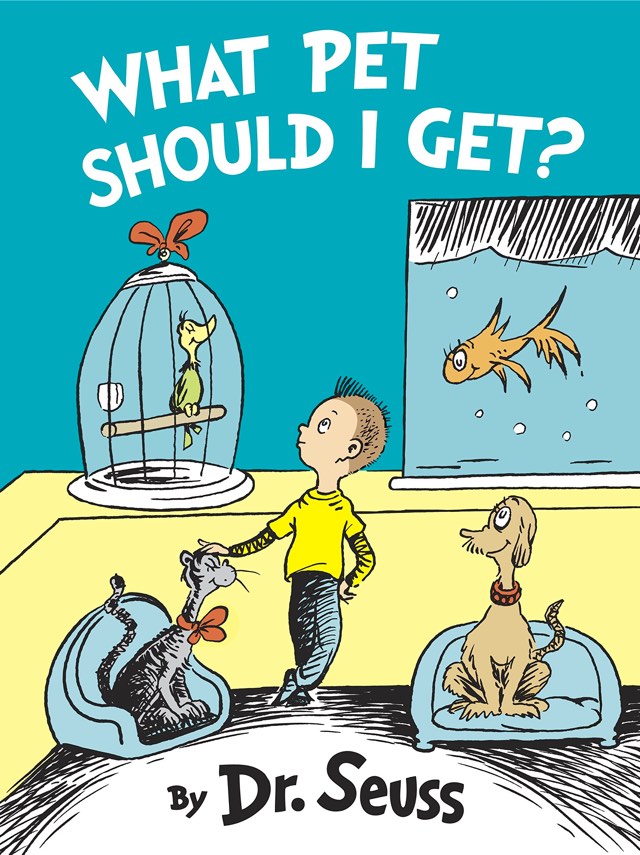 3) What Pet Should I Get? As you have no doubt heard, a new Dr. Seuss book will be published this July. People have been asking me about it.  Here are a few answers to your questions.
3) What Pet Should I Get? As you have no doubt heard, a new Dr. Seuss book will be published this July. People have been asking me about it.  Here are a few answers to your questions.
Q: Have you seen it?
A: No. The manuscript is among the materials donated by Audrey Geisel (Seuss’s widow) to UCSD’s special collections in 2013 & 2014. I haven’t done research there in about ten years; I was last there in 2007, to give a lecture.
Incidentally, in its story on the news of this donation, the San Diego Union-Tribune published a page from what appears to be What Pet Should I Get? It seems that the book’s working title was Pet Store.
Q: Is it legit?
A: I have no reason to doubt its legitimacy. In addition to the existence of the above page (evidently from the book in question), Seuss wrote far, far more than he published. As he once said, “To get a sixty-page book, I may easily write a thousand pages before I’m satisfied!”
During the period that he wrote it (1958-1962, according to the press release), Seuss was so prolific that he started to publish books under other pseudonyms – that way, “Dr. Seuss” wouldn’t have more than one book coming out each season. The first such book was Ten Apples Up on Top! (1961), illustrated by Roy McKie and credited to Theo. LeSieg (which is “Geisel” backwards). All the LeSieg books were not illustrated by Seuss. Most were done by McKie, but several featured the art of others, including New Yorker cartoonists B. Tobey, George Booth, and Charles E. Martin.
Since there were already two of his books coming out in 1961 (The Sneetches and Other Stories, and Ten Apples Up on Top), Seuss may have decided against publishing another that year – or in whatever year he wrote it. He published two books in 1958, one in 1959, and two in 1960, one of which was One fish red fish blue fish.
Q: The press release says the book features the two children from One fish two fish red fish blue fish. What do you make of that?
A: One fish two fish red fish blue fish is a non-narrative book – Seuss’s first children’s book to lack a story. It’s more of a concept book, a series of episodes in which various fantastical creatures appear. The boy and the girl recur in a dozen or so of these episodes, most of which are only a couple of pages long.
My guess is that, while writing One fish two fish red fish blue fish, Seuss found himself with a full-length story featuring the book’s unnamed brother and sister. Since there was no room for an entire, book-length narrative in this collection of small episodes, he cut it.  Or, he may have written the full story first – What Pet Should I Get? – and then, one section of it inspired him to create (instead) an entire non-narrative book featuring the two children and the curious animals of One fish two fish red fish blue fish.  A third possibility is that What Pet Should I Get? is an earlier version of what became One fish two fish red fish blue fish.
For more, tune into Wisconsin Public Radio during the 5 o’clock hour (Central Time) today – probably at 5:40 pm.
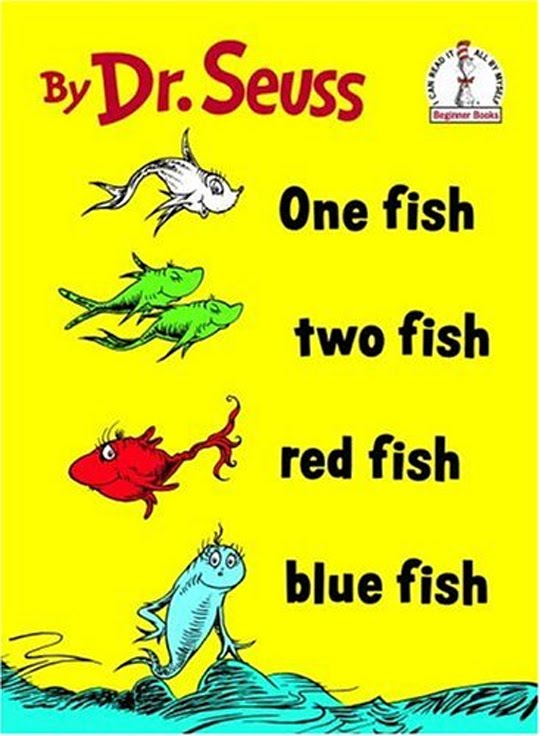 4) The Fish in the Court.  Speaking of One fish two fish red fish blue fish, Justice Elena Kagan cited the book in a Supreme Court case last week.  The gist of the case (Yates v. United States) is that, when caught with undersized grouper, a Florida fisherman attempted to get rid of the evidence by throwing it (all of the fish) back into the sea. Officials charged the fisherman under the Sarbanes-Oxley Act, which prohibits destroying “any record, document, or tangible object” that might impede a federal investigation. In a 5-4 ruling, the Supreme Court actually sided with the fisherman, ruling that Sarbanes-Oxley only applied to documents and not to fish.  In her dissenting opinion, Kagan disputed the notion that a fish is not a “tangible object”:
4) The Fish in the Court.  Speaking of One fish two fish red fish blue fish, Justice Elena Kagan cited the book in a Supreme Court case last week.  The gist of the case (Yates v. United States) is that, when caught with undersized grouper, a Florida fisherman attempted to get rid of the evidence by throwing it (all of the fish) back into the sea. Officials charged the fisherman under the Sarbanes-Oxley Act, which prohibits destroying “any record, document, or tangible object” that might impede a federal investigation. In a 5-4 ruling, the Supreme Court actually sided with the fisherman, ruling that Sarbanes-Oxley only applied to documents and not to fish.  In her dissenting opinion, Kagan disputed the notion that a fish is not a “tangible object”:
As the plurality must acknowledge, the ordinary meaning of “tangible object” is “a discrete thing that possesses physical form.” Ante, at 7 (punctuation and citation omitted). A fish is, of course, a discrete thing that possesses physical form. See generally Dr. Seuss, One Fish Two Fish Red Fish Blue Fish (1960). So the ordinary meaning of the term “tangible object” in §1519, as no one here disputes, covers fish (including too-small red grouper).
You can read the entire ruling on the Supreme Court’s website. Â The above appears on page p. 29 of the pdf – p. 2 of Kagan’s dissent.
Thanks to Gary R. Dyer and Nathalie op de Beeck for the tip.
5) The Dr. Seuss Rap Quiz
Which of the following groups has no songs that reference Dr. Seuss? Also, if you try to Google this, you may get the occasional NSFW lyric. So,… don’t use Google. Use your brain. Choose only the correct answer or answers.  First person to get the right answer will receive a Seuss-ish gift. Seriously.
A) A Tribe Called Quest
B) Beastie Boys
C) Blackalicious
D) Michael Franti & Spearhead
E) RUN-DMC
F) 3rd Bass
Tomorrow, I will post the answer at the very end of this post. I will also tell you which of these artists’ songs include references to Seuss or his works.
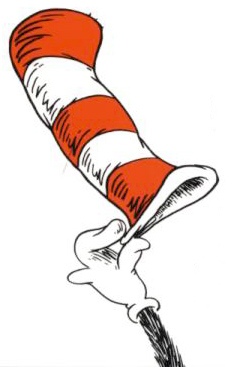 6) Was the Cat in the Hat Black? LIVE! March 10th! That’s “LIVE!” as in “LIVE in concert” because, on March 10th, I’ll be giving a fully illustrated version of this talk plus (for the first time!) some of the introduction to the book of which it will be a part.  When? Where?
6) Was the Cat in the Hat Black? LIVE! March 10th! That’s “LIVE!” as in “LIVE in concert” because, on March 10th, I’ll be giving a fully illustrated version of this talk plus (for the first time!) some of the introduction to the book of which it will be a part.  When? Where?
It’s at 4:15 pm, Watson Forum, at DePauw University, in Greencastle, Indiana.  More details via DePauw’s Dept. of English “Events” page.  Another reason for you to come: Michelle Martin will be giving a talk at 7:30 pm, in the Prindle Auditorium: “From the Kitchen to the Edges: Hair Representations in African American Children’s Picture Books.”  These are free and open to the public.
Since it is Seuss’s birthday, you might enjoy perusing other posts tagged Seuss.  Here’s a selection:
- Oh, the Quotations You’ll Forge! (2 Mar. 2014). Seuss’s pithy verse is very quotable. Unfortunately, people have a habit of attributing things to him that he never said. This post exposes some fake Seuss, and gives you plenty of quotations that he actually did say.
- Happy birthday to Dr. Seuss! A guest post by Charles D. Cohen (2 Mar. 2013). Â Birthday reflections from Seussologist Charles Cohen (The Seuss, the Whole Seuss, and Nothing But the Seuss). Quotes some original verse by Seuss, including “Pentellic Bilge for Bennett Cerf’s Birthday” (1940).
- How to Mispronounce “Dr. Seuss” (6 Feb. 2013). Also: how to pronounce “Dr. Seuss.”
- I Am the Lorax. I Speak for the Theeds? (3 Mar. 2012). Some thoughts on The Lorax film and its attendant advertising.
- Dr. Seuss: children’s books “have a greater potential for good or evil, than any other form of literature on earth.” (1 Mar. 2012). A 1960 essay by Seuss on writing for children.
- Dr. Seuss on “conditioned laughter,” racist humor, and why adults are “obsolete children” (16 Jan. 2012). A 1952 essay by Seuss on humor.
- Seussology (15 Jan. 2012): On my graduate-level “Dr. Seuss” course.
- Oh, the Thinks That He Thought! Some of Seuss’s Lesser-Known Works (2 Mar. 2011): My post for Dr. Seuss’s birthday in 2011.
- You’re a Mean One, Mr. Grinch (20 Dec. 2010): 15 versions of the song.
- Corporate Seuss; or, Oh, the Things You Can Sell! (21 Aug. 2010). Ted Geisel was first famous for advertising, not children’s books.
Occasionally, I get asked to talk about Dr. Seuss:
- “New Window into Dr. Seuss’s genius” (26 Feb. 2014). John Wilkens’ article in the San Diego Tribune discusses new Seuss material that his widow, Audrey, donated to the Dr. Seuss Papers at UCSD.
- “Dr. Seuss: Mini-Biography.” A&E Biography (2013).  Time: 4 minutes.
- All Things Considered. Lynn Neary, “‘The Bippolo Seed’ : The ‘Lost’ Dr. Seuss Stories” (13 Apr. 2011):Â audio & transcript. Â Charles Cohen & I talk about the new book of “lost” Seuss stories (edited by Charles). Â Time: 3 mins, 30 secs.
- Diane Rehm Show. Dr. Seuss’s How the Grinch Stole Christmas! (22 Dec. 2010): audio | transcript. Reverend Derrick Harkins, Maria Salvadore, and I talk with Diane Rehm about the Grinch.  Time: 1 hour.
- Morning Edition. Lynn Neary, “Fifty Years of The Cat in the Hat” (1 Mar. 2007):Â audio & transcript. Anita Silvey and I talk with Lynn Neary about the Cat in the Hat. Â Time: 7 mins, 20 secs.
- Talk of the Nation. Â Steve Inskeep, “Celebrating the 100th Birthday of Dr. Seuss: A New Book Looks Back on the Life of Theodor Geisel” (10 Feb. 2004):Â audio. Â I was a bit nervous at the beginning (I believe it was my first time on live national radio), but after the first few minutes I seem to settle into it well enough. Â Time: 1 hour.
| Though the website appears to have been designed to impede its utility, Random House’s Seussville‘s author section includes a bio. and timeline I wrote – the former heavily influenced by Judith and Neil Morgan’s excellent Dr. Seuss & Mr. Geisel.  (If you read only one book about Dr. Seuss, the Morgans’ bio is the one I’d recommend.)And… that’s all.  Happy Read Across America Day!*
*Each year on or near March 2nd (the birthday of Theodor Seuss Geisel, a.k.a. Dr. Seuss), the National Education Association sponsors Read Across America, designed to promote literacy. This year, it’ll be celebrated on Monday, March 3rd. Read more about it at the NEA’s website. |
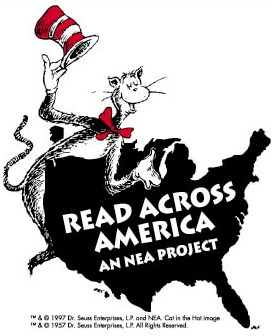 |
ANSWER TO QUIZ (added 3 March 2015)
Alas, Cat’s valiant guess proves incorrect. Â Apart from her, no one else took a stab at the question. I put the quiz in at no. 5 to see if anyone would actually read that far down. Either only Cat did, or my quiz measured not readership but the difficulty of answering the question.
The correct answer is C) Blackalicious.  You’d think that the group behind “Alphabet Aerobics” would have a song that references Dr. Seuss.  But, as far as I know, they don’t.  A Tribe Called Quest has an R-rated Seuss reference in “Clap Your Hands” (1993).  Seuss’s Green Eggs and Ham makes an appearance in Beastie Boys’ “Egg Man” (1989) and gets alluded to in 3rd Bass’s “Pop Goes the Weasel” and “Green Eggs and Swine” (both 1991).  RUN-DMC name-checks Seuss in “Peter Piper” (1986), and Michael Franti & Spearhead’s “East to the West” (2006) mentions “the Lorax who speaks for the trees.”

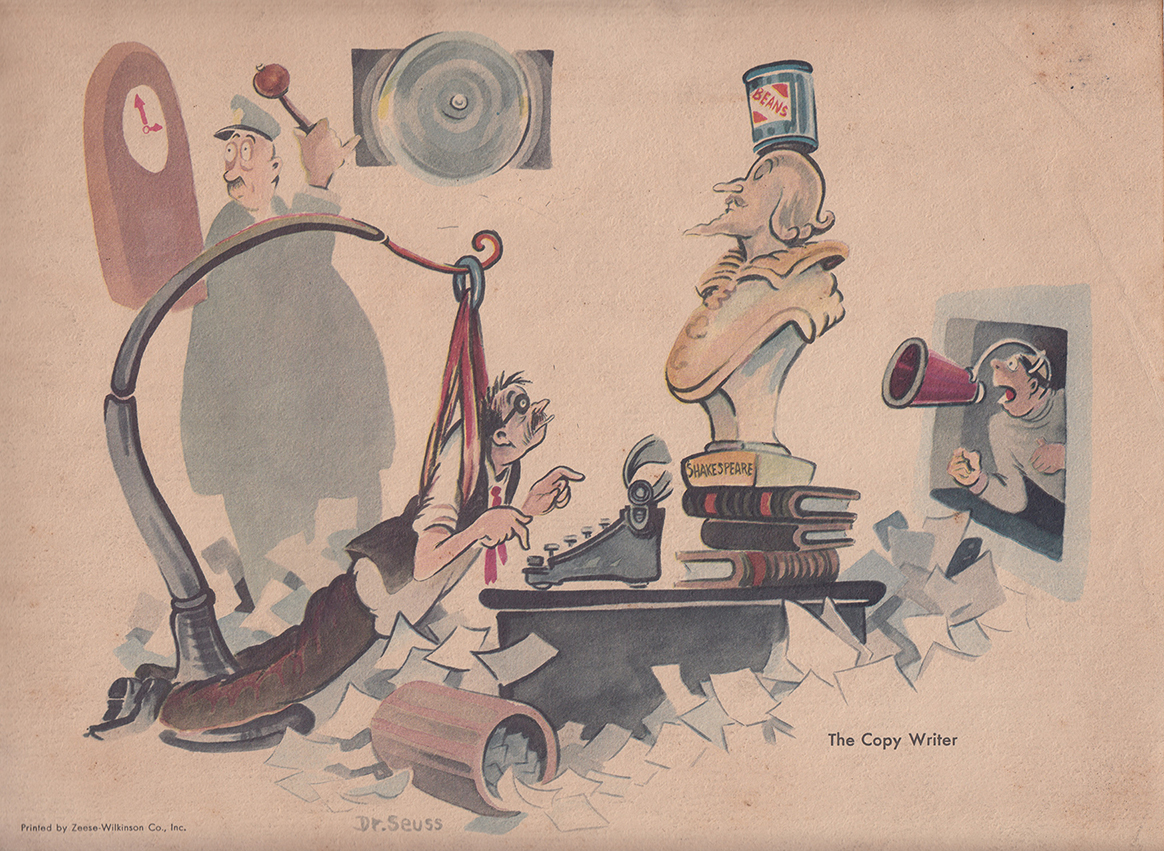
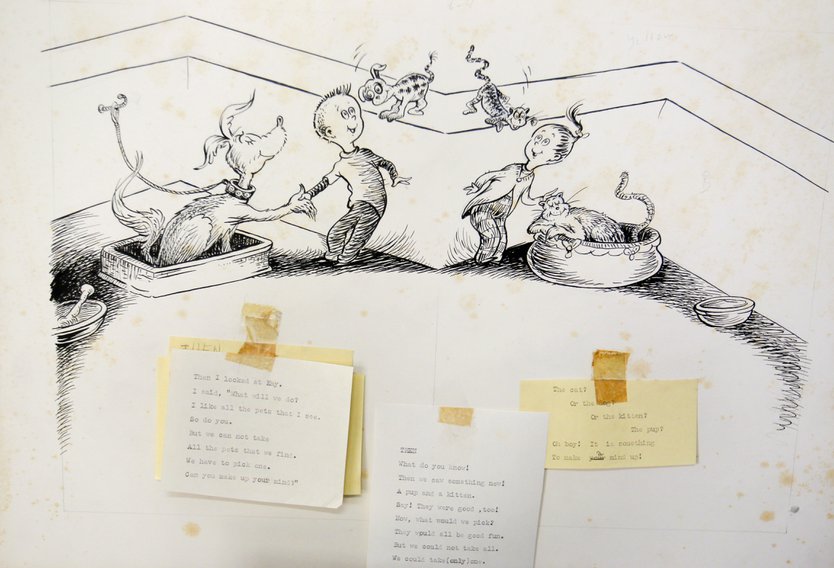
Cat
Charles Augustus Steen III